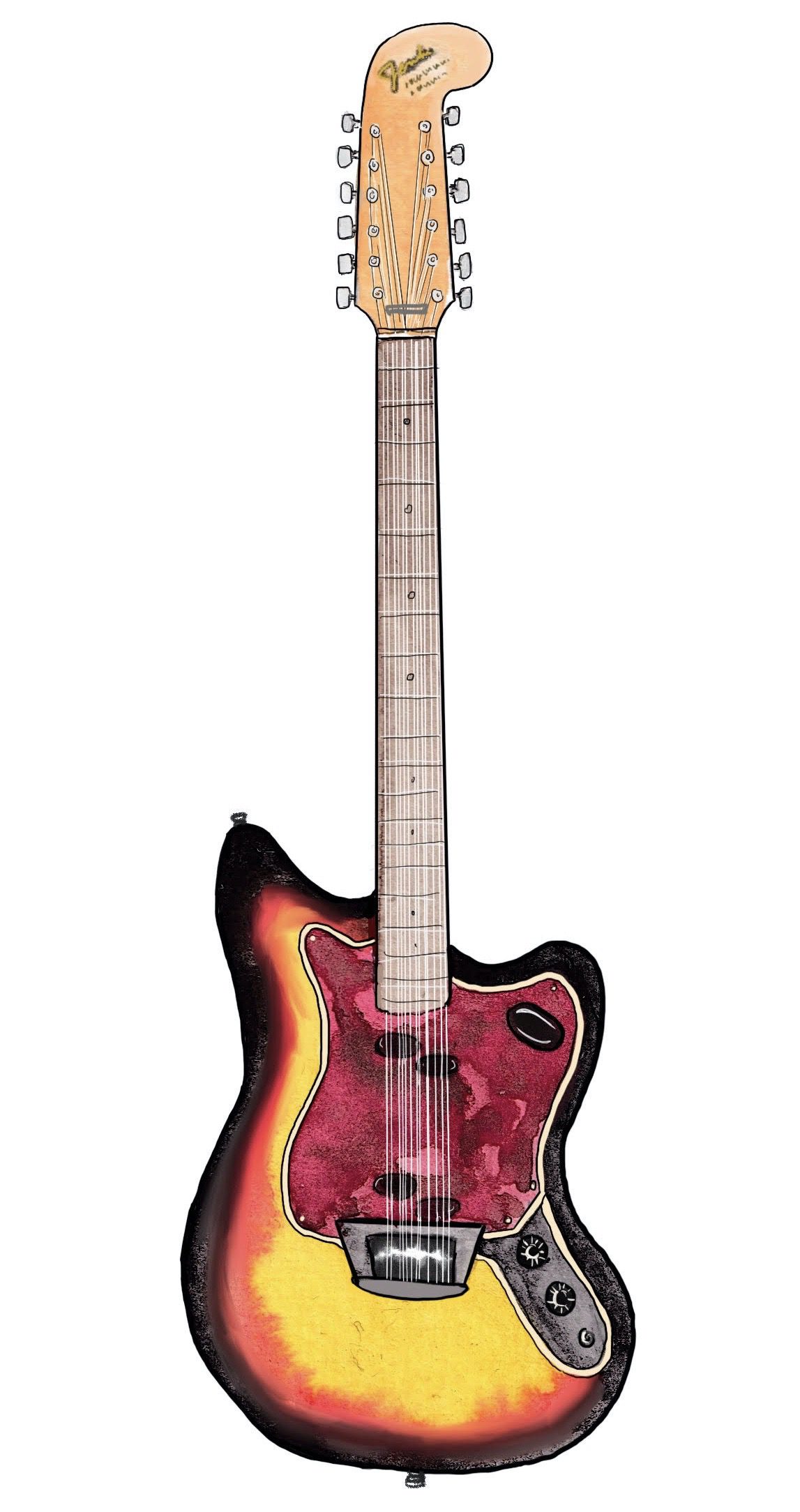
Two years ago I was commissioned to present music here in London at The Barbican. I had done work with them through the years in different capacities, but usually as a bit of a guest to somebody else. And so it came time for me to present something myself, and a place like that always likes to have something special.
Usually when it’s people coming out of the rock music world, I noticed it was always a band or musician working with something like the London Sinfonietta Orchestra, and the idea was to expand the language of rock, which was kind of cool. I had actually done something like this with the artist Christian Marclay, but I didn’t want to do that here. I kind of blurted out that I wanted to do a piece for twelve 12-string guitars. I wanted to have the concert be one hour of acoustic 12-string guitars followed by an hour of electric 12-string guitars.
The challenge was that 12-string guitars are rather difficult to find. For one thing, the most well-known electric model, made by Fender, was only in production for about five years, from ‘65 to about ‘70, I think. Even though it’s known as the “Stairway to Heaven” guitar, and was also played by Pete Townshend, Johnny Winter, Lou Reed, and others, it’s often considered a kind of specialized or novelty guitar. Still, I wanted to show it had equal value to other guitars.
I kept thinking, “Who do I know who has a 12-string guitar and will play with me?” I reached out to musicians I thought would be compatible—some people had the guitars and for others I was able to borrow some, and get some gifted from Gretsch.
Then, as I was preparing for the composition, my girlfriend Eva gave me a beautiful Fender electric XII. She said, “I know your birthday is five months from now, and you’re turning sixty. That’s a big life change number, so I need to give you this guitar.”
It was so beautiful, and such an incredible gift. I immediately locked the door, sat down, and wrote the music for 12-string guitars for twelve musicians. A couple of the players were of high technique but not all of them. My thought was that if they could play a modicum of guitar and read the notation, I could keep the piece very simplistic. A lot of it had to do with dynamics.
The Barbican concert was wonderful, and really fun, and it led me into wanting to sort of put the idea of sixty-minute instrumental pieces for 12-string guitar into more of a rock band context with the band I have here in London, which is myself, Debbie Googe (the bass player in My Bloody Valentine), James Sedwards (an incredible guitarist who I started playing with when I first moved here), and the drummer Steve Shelley from Sonic Youth.
The first piece I wrote was called “Alice Moki Jayne,” in honor of three women who I think are visionaries: the musician Alice Coltrane; the visual artist Moki Cherry; and the poet Jayne Cortez, whose work spoke of power, resistance, and resilience. Some of the motifs in the music also reminded me of the music I was hearing in Alice Coltrane’s devotional music, which she wrote as a practitioner and scholar of Buddhist thought and philosophy.
The band toured with the music for almost a year and a half, and we really got lost in it. I don’t think the audiences had any expectation for us to come out and do such a thing, and after ten or fifteen minutes you could really see this kind of invisible sort of word balloon, asking what is this? Why does this music keep blossoming?
There was this excited energy in the room, and it brought me back to a lot of music I was involved with in the late ‘70s and early ‘80s in New York City when I was playing in experimental guitar ensembles with composers in the downtown scene like Rhys Chatham and Glenn Branca. When Sonic Youth first started, Lee [Ranaldo] and I played with Glenn and Rhys, and our band became more of a rock band consolidating a lot of the ideas we were hearing while keeping true to our own vocabulary. That inspiration continues to be true for me today.
Playing a 12-string electric guitar has its challenges. It can be a slight bit of a beast to string and tune it. When you play it, you’re less likely to be able to bend strings, which is a common technique. You can’t shred on it the same way as on a 6-string, and you need a bit more delicacy. But I’ve been using it more and more in my music. In fact, just today I was recording music for a film project by a filmmaker here in London on my electric 12-string. You can also see it in the music video for the song “Cantaloupe” on my new album. Even though I’ve only had my 12-string for two years, this is my favorite guitar.
***
Wanted/Needed/Loved: Musicians and the Stuff They Can’t Live Without is an illustrated column where musicians share the stories behind meaningful objects. As told to Allyson McCabe and illustrated by Esme Blegvad.
***
Ranked by Rolling Stone and SPIN as one of the greatest guitarists of all time, Thurston Moore is best known as a founding member of Sonic Youth. He has also participated in many solo projects and collaborations as well as running the Ecstatic Peace! record label. Last month, Moore released his seventh solo album, By the Fire, featuring musicians Deb Googe (My Bloody Valentine) on bass and backing vocals, Jon Leidecker aka “Wobbly” (of Negativland) on electronics, James Sedwards on guitar, and Sonic Youth’s Steve Shelley, as well as Jem Doulton, alternating on drums. Moore describes the songs as “flames of rainbow energy, where the power of love becomes our call. These are love songs in a time where creativity is our dignity, our demonstration against the forces of oppression.” Rolling Stone calls them “mesmerizing” and The Independent says they’re “righteous.”






